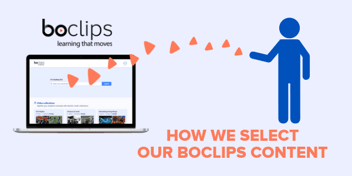As an ex-teacher, it’s really important to me that videos work well for all the students in my class, if and when I’m going to use them. Learning time is precious, and it’s often hard to work out what does and doesn’t help a student to engage with a topic and make progress. Videos can be a great source of inspiration and a good way to visually convey difficult and dense information. That’s why at Boclips we apply some rigorous editorial standards to our video selection.
So here is an overview of what we look for in the videos we acquire:
- Engaging
As much as possible we want our videos to grab attention, make learning fun, and show students what happens when academic concepts get applied to real-world scenarios. Explosions, space travel, rare archive footage, and fantastic animations — we want it all. We often ask our users and third party educators to review our content to make sure we are selecting videos suitable for the classroom.
- Cohesive
The videos have to make sense. It sounds obvious, but it’s important not to forget it! A video shouldn’t just make sense to a teacher who’s taught that topic four years in a row; it has to make sense to all of their students and their varying needs. There’s no point in having a video without sound if a student struggles with subtitles; there’s no point in using a video that has false facts or fake images. We apply the same standards to our videos as our users do to their learning resources, textbooks, and lesson planning.
- Informative
There are lots of different kinds of learning in the classroom; remembering, understanding, applying, analyzing and synthesizing are all important parts of a student's journey through a topic. We believe it’s important that we have videos that cover as many of these stages as possible—from that first inspirational ‘WOW’ as the rocket launches on-screen, to the in-depth understanding that comes from hearing an astronaut speak about their experiences, to learning how to make a rocket yourself from cardboard and tape.
- Shareable
At Boclips we want our users to talk about all the great stuff that they find on our website. If we think that our videos are good enough for a teacher to play to their class, for a publisher to include it in learning resources, and for a user to share a collection with their colleagues and community, then we’ve done our job well. Truly great video learning is something we know teachers come back to time and again.
<<Want to find out more about a curated, copyright-cleared solution to your video procurement needs? Schedule a consultation>>
That’s not all, though! We like to make sure we’re keeping to our standards too. After I’ve taken a look at videos with my ‘teacher eye,’ We like to give it a score based on:
- Popularity with teachers online
- The video’s relevance to curriculums around the globe
- Whether it’s ever been suggested by any users previously
All of these elements tell us how useful, trustworthy and valued the content is likely to be once it’s on the platform. If we’re still unsure, we’ll go straight to third-party educators and get them to do an in-depth review for us where we can establish what works, and what doesn’t.
User, teacher, and publisher feedback are paramount so that we can provide our end-users, students, with the best learning experiences and be a reliable, trustworthy and inspirational resource in any educators' toolkit.
- #Classroom
- #Video in Digital Learning
- #Educational Videos
- #Tips for Using Video
- #Video Content Partners
- #Boclips for Publishers
- #Issues in Education
- #Educational Videos by Subject Area
- #News and Announcements
- #Events & Holidays
- #Video and Teaching Tools
- #Teaching Methodologies
- #Education Videos
- #Video and Digital Literacy
- #Short Educational Videos
- #Instructional Design
- #Multimodal Learning
- #Video and Student Safety
- #Accessibility in Education
-3.png?width=390&height=223&name=Untitled%20design%20(2)-3.png)


.png?width=1152&height=660&name=Copy%20of%20Untitled%20Design%20(1).png)




